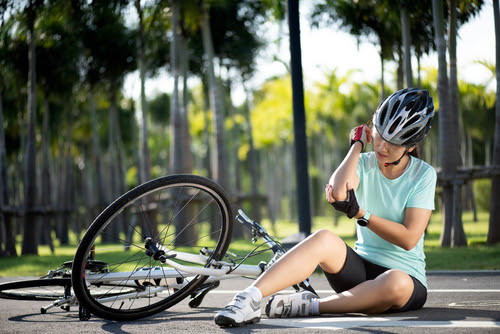Bike Falls: Are You Still Feeling the Effects?
Bike fall in your past?
When people come in with mystery pain, a common incident in their past is a bike fall. They often say, “I was fine, nothing was broken.”
However, nothing broken doesn’t mean the incident was without lasting consequences.
Often a bike fall, whether recent or a long time ago, is the cause of a rigid core which is creating stress at your hip or shoulder.
Our clients find after their Bridging session, the trauma is cleared, their core relaxes, and the pain or stiffness fade away.
Repeatedly, we hear the phrase “magic”!
You or your loved one had a close encounter with the ground while riding a bike.
What should you/they do next, and why there is more to consider to the impact? Here are some pointers to help think it through in more detail.
How soon after a bike accident can you get Bridging® help?
Ideally you want to address a bike fall when it’s fresh in order to calm the nervous system and help speed up recovery. Of course, make sure any acute injury is evaluated for more specific medical support. We can still help when the fall was a while ago, yet you are still feeling the effects.
What really happened when you fell?
There are seven aspects of a bike fall that we find can impact you in the long term, often causing lingering, mystery pain.
We start by identifying additional aspects of the incident. There are many other traumas with a bike fall which you don’t think about because another body part was screaming louder.
- What did you hit — ground, grass, etc?
- Which parts of you hit something — ground, bike, vehicle?
- And which parts of you were struck by a door, bike, etc.?
- Which direction did you fall?
- What did the bike hit — your leg, arm, etc?
- Were your feet clipped in?
- Did your head get hit? And did you have a helmet on?
How do we help you, given the information about the fall?
Each answer to these questions is a guide to reconstructing a scenario to address the many, disparate aspects of the incident.
Replicating the position of impact is integral to putting the muscle function back together. It’s kind of like rewinding a video to understand how your neuromuscular system was impacted as a whole.
This is important because your nervous system is still frozen into the odd combination of twists and forces. Even though you can move, there is an underlying skew and rigidity from the impact. Bridging® allows your nervous system and muscles to release the trauma and relax.
How often do you need to come in to resolve the issues?
It depends. By taking the time to gather information and factor in so many variables, we can help you feel better very quickly. Depending upon the exact extent of the incident, 2-3 sessions are pretty common to resolve the full extent of the trauma.
Just imagine, you’ll feel relaxed and your joints will be moving without pain!
There’s so much more to recovering from a fall than strength and range of motion!
Bridging® restores how your muscles hand-off to each other as you shift positions, speed-up and slow down, bend, flex, and turn.

